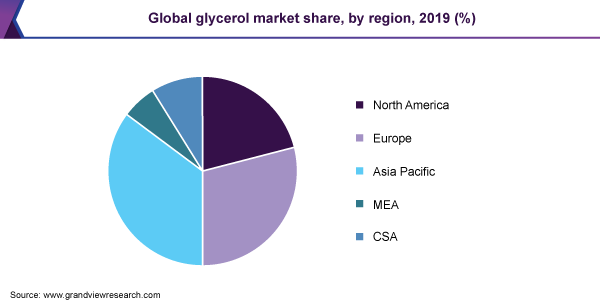Glycerol Market Growth & Trends
The global glycerol market size is expected to reach USD 3.5 billion by 2027, expanding at a CAGR of 4.0%, according to a new report by Grand View Research, Inc. Improved standard of living coupled with growing consumer demand for high quality and innovative personal care products is expected to drive the market over the forecast period. Glycerol which is also known as glycerin is colorless, odorless, vicious, and oily liquid having syrupy sweet flavor. The product can be derived naturally from vegetable oils such as soybean, corn, coconut, palm, animal fats such as tallow, and synthetically from propylene. In the recent years, biodiesel has been a major source for product development owing to the growing awareness towards the use of biofuels across the globe. The product is generally obtained as a byproduct during biodiesel production. Augmented production and consumption of biodiesel has positively impacted the market over the years.
Commercially, it is sold in crude and purified forms. The crude glycerol contains impurities such as heavy metals salts and alcohols which is further purified using purification techniques for its further use in end use applications such as pharmaceutical, food, and personal care. The purity requirement depends on the purpose for which the product is being used. For instance, the glycerol used in cosmetics and pharmaceutical applications require 90.0% purity as compared to other applications. However, the purification process is slightly expensive which is expected to pose a threat to market growth.
In cosmetics, glycerol is the third most used ingredient after water and fragrance in cosmetics formulations. The product primarily functions as a denaturant, humectants, and skin protectant. In addition, it is also used in over-the-counter drugs such as ophthalmic drug products (up to 1%), dermal protectant (up to 45%), and external analgesic.
Asia pacific is one of the prominent consumers as well as exporter of glycerol with major exporting countries being Indonesia and Malaysia. Abundant raw material availability and high biodiesel production is further contributing to the glycerol production in the region. Europe is one of the top importers of glycerol with Russia, Germany, Netherlands, and Denmark contributing to the largest imports in the region.
However, the recent outbreak of COVID-19 pandemic is expected to create a demand supply gap for the market owing to the downfall in biodiesel production, disrupted logistic services, and lack of labour force. The significant fall in biodiesel production is expected to directly affect the global glycerol prices, resulting in higher prices as biodiesel accounts for key raw material used in its production.
The regulatory norms associated to glycerol are stringent and are required to be followed at both national and international levels. The product is regulated as a food additive by the European Commission under Regulation (EU) No 231/2012. In addition, it is also regulated as Generally Recognized as Safe (GRAS) by the U.S. FDA for its use in food packaging materials.

Request a free sample copy or view report summary:
Glycerol Market Report
Glycerol Market Report Highlights
- The market for glycerol is likely to generate a demand for 5.5 million tons by 2027
- In terms of revenue, Asia Pacific emerged as the fastest growing region in the market across the globe
- The personal care and cosmetics segment emerged as a prominent end-use segment with a market share of approximately 37.0% by volume in 2019
- In Asia Pacific, countries particularly India and China are likely to witness a remarkable market growth in next seven years
- The industry is fragmented and competitive in nature, with presence of major global players such as BASF SE, Dow , Cargill, Incorporated, Kao Corporation, and Oleon NV
- Growing demand for natural, innovative, and sustainable products is expected to drive the product consumption in cosmetics and personal care products
- In its refined form, the product is used as a pharmaceutical excipient to formulate several over the counter drugs. Glycerol used in pharmaceutical formulations needs to be of high quality and purity.
- In recent years, biodiesel is majorly used as a raw material for extracting glycerol. The product is generally obtained as a byproduct during biodiesel production. Growing consumer preference towards natural and environmentally friendly products has bolstered the growth of the biodiesel market, which in turn, is positively impacting the glycerol production globally.